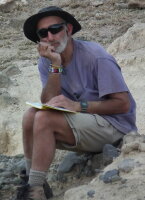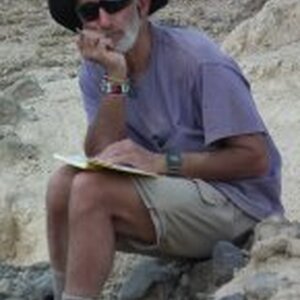
Contact Information
607 S Mathews Ave.
M/C 148
Urbana, IL 61801
Research Interests
Africa
Archaeology
Modern Human Origins
Lithic Technology
Stable Isotope Ecology and Paleoecology
Evolution of Human Diet
Evolution of Cooperation
Behavioral Neuroendocrinology
Education
PhD Berkeley, Anthropology, 1984
Post-doctoral Scholar, UCLA, 1984-85
Courses Taught
African Prehistory (ANTH 448)
Analysis of Lithic Technology (ANTH 452)
History Of Archaeological Theory (ANTH 461)
History of Human Evolution (ANTH 242)
Research Design and Proposal Writing (ANTH 511)
Evolution of Humans and Culture (ANTH 102)
Archaeometry: Sci methods in archaeol (ANTH 499SA)
Additional Campus Affiliations
Affiliate, Earth Science and Environmental Change
Professor, Center for African Studies
Professor, Center for Global Studies
Affiliate, Carl R. Woese Institute for Genomic Biology
External Links
Highlighted Publications
1. THE ARCHAEOLOGY OF MODERN HUMAN ORIGINS IN EAST AFRICA. We are investigating the chronology of the Middle Stone Age (MSA) by dating volcanic ashes in archaeological sites in the Kenya Rift Valley in collaboration with Mwanzia D. Kyule, Mulu Muia (U. Nairobi), Martin A.J. Williams (U. Adelaide, Alan Deino (Berkeley Geochronology Center) and Ian Steele (U. Chicago). Several sites document the Acheulean to MSA, and MSA to LSA transitions.
3. LATE PLEISTOCENE HUMAN POPULATION HISTORY AND CLIMATE CHANGE. The penultimate ice age and abrupt climate changes at the beginning of the last ice age, particularly the supereruption of Toba (Sumatra), may have caused several severe bottlenecks in African human populations. Environmental stresses may have promoted the evolution of social cooperation that facilitated subsequent dispersals out of Africa. These dispersals may have resulted in additional population bottlenecks in the populations that left Africa during the early last glacial. Evidence for changes in social and territorial organization in Africa during the last Ice Age is being obtained from our current fieldwork in Kenya.
2. OBSIDIAN SOURCE SURVEY IN KENYA. We are currently studying the evolution of macro-regional exchange networks by obsidian artifact source and MSA and Early LSA artifact chemistry in collaboration with Jeffrey Ferguson and Michael Glascock of the University of Missouri Research Reactor Archaeometry Laboratory. Electron microprobe analysis of sources is being performed by UIUC graduate student Philip Slater in the UIUC Geology Department Microprobe Lab, directed by Professor Craig Lundstrom. Philip Slater, and John Munyiri (National Museums of Kenya) are participating in source collection and artifact assemblage sampling.
4. GLACIAL REFUGIUM IN SW ETHIOPIA. The impact of last glacial climate changes on the distribution of human population refugia in southern Ethiopia is being studied by isotopic analysis of paleosols along an altitude transect from the upper Omo Valley to Mt. Damota in Wolayta Province in collaboration with a team led by Steve Brandt (U. Florida) and Elizabeth Hidebrand (SUNY Stony Brook). UIUC graduate student Yu Dong (Doreen) is preparing samples for carbon isotope analysis.
6. RECONSTRUCTING EARLY ETHIOPIAN HOMINID ENVIRONMENTS WITH STABLE ISOTOPES. We are using carbon and oxygen isotopes of fossil soils and herbivore tooth enamel to reconstruct terminal Miocene through Pleistocene hominid habitats in the Middle Awash Valley, Ethiopia, with the research team directed by Tim White (Berkeley) and Giday WoldeGabriel (Los Alamos National Laboratory), Plio-Pleistocene sites in Konso, Ethiopia, with the research team led by Gen Suwa (Tokyo), Shigehiro Kato (Hyogo Museum), Japan, and Yonas Beyene (ARCCH) and Berhane Asfaw (Rift Valley Research Services), Ethiopia. We are testing models of the relationship between the appearance of grasslands and the evolution of bipedalism, and patterns of seasonal variation in diet and climate, in order to test “variability selection” models in human evolution.
5. TOBA ASH AND PALEOSOL ISOTOPES IN INDIA. The impact of the Toba eruption on the landscape of central peninsular India is being studied by isotopic analysis of paleosols stratified above and below the volcanic ash in collaboration with Martin A.J. Williams (U. Adelaide), Parth Chauhan (Stone Age Institute, Indiana U), and Umesh Chattopadhyaya and Jagganath Pal (U. Allahabad), and another team led by Michael Petraglia (Cambridge) in southern India.
8. ENVIRONMENTAL ISOTOPE PALEOBIOGEOCHEMISTRY LABORATORY. The laboratory is equipped for preparing bones, teeth, soft tissues, plants, carbonized potsherd residues, soils and shells for carbon, nitrogen and oxygen isotopic analysis. Our Finnegan MAT 252 mass spectrometer permits automated analyses of sub-milligram samples of organic matter, and carbonates, and analysis of incremental growth structures. Current research projects include investigating pastoral herd management strategies in Kenya, South Africa, Scotland, and Iran determining pastoral site function and structure in Kenya, pottery functions in eastern North America, and human subsistence strategies in the USA, China, Peru, Zimbabwe, Pakistan, Israel, Denmark, highland Mexico and elsewhere.
9. STRONTIUM ISOTOPE ANALYSIS OF TRADE, EXCHANGE, MOBILITY AND TRANSHUMANCE. Analyses of bones, teeth and shells are being performed in the UIUC Geology department ICP-MS laboratory (Nu Instruments multi-collector mass spectrometer) directed by Craig Lundstrom and Tom Johnson, to investigate transhumance, mobility, trade and exchange patterns, including elephant ivory in East Africa (Ashley Cotou, York U.), ostrich eggshell beads of the Kalahari San (Polly Wiessner, U. Utah, Marina Sergeyeva, UIUC), humans in Ghana (Abbie Thompson, Wash. U.), Middle Woodland of eastern North America (Dana Beehr, UIUC), and stock exchange patterns in the Thukela Valley, South Africa (Elizabeth Arnold, SSRC Canada Post-doctoral scholar, UIUC).
7. GEOLOGY AND PALEOECOLOGY OF TERMINAL MIOCENE FOSSIL SITES IN SOUTHWEST KENYA. Fossil-bearing sediments of a paleolake basin dating to 6-5.8 million years, named the Lemudong’o Formation, have been studied with a team led by Leslea Hlusko (Berkeley), in collaboration with Christopher Nyamai and Eliud Mathu (Geology, U. Nairobi), Martin A.J. Williams (U. Adelaide) and Alan Deino (Berkeley Geochronology Center), and many paleontological specialists with support from the Revealing Hominid Origins Initiative (NSF-HOMINID) program directed by Tim White and F. Clark Howell (Berkeley). Research to 2006 is summarized in Kirtlandia vol. 57 (2007).
Recent Publications
Hošek, J., Hošková, K., McCool, J. P., Varadzinová, L., Pokorná, A., Juřičková, L., Ambrose, S. H., & Varadzin, L. (2024). Fossil spring records from central Sudan reveal paleoenvironmental and settlement dynamics in the Eastern Sahel during the last 30 ka. Quaternary Science Reviews, 344, Article 108928. https://doi.org/10.1016/j.quascirev.2024.108928
Martin, N., Thibeault, A., Varadzinová, L., Ambrose, S. H., Antoine, D., Brukner Havelková, P., Honegger, M., Irish, J. D., Osypiński, P., Usai, D., Vanderesse, N., Varadzin, L., Whiting, R. J., Velemínský, P., & Crevecoeur, I. (2024). From hunter-gatherers to food producers: New dental insights into the Nile Valley population history (Late Paleolithic–Neolithic). American Journal of Biological Anthropology, 184(4), Article e24948. https://doi.org/10.1002/ajpa.24948
Qiu, Y., Shu, P., Ao, H., Zhang, Y., Wei, Q., Li, X., Chen, H., Wang, H., & Ambrose, S. H. (2024). The earliest microblade site 6800 years ago reveals broader social dimension than previous thought at the central high altitude Tibetan plateau. Quaternary Science Reviews, 328, Article 108551. https://doi.org/10.1016/j.quascirev.2024.108551
Wang, H., Li, H., Qiu, Y., Shu, P., Liu, Y., Liu, W., Sun, J., Du, S., Wang, J., & Ambrose, S. H. (2024). Seasonal landscape variability advances Lantian hominin's recognition capacity to strategically adapt to changing environments. Quaternary Science Reviews, 336, Article 108786. https://doi.org/10.1016/j.quascirev.2024.108786
Ambrose, S. H. (2023). Archaeology and Linguistic Reconstructions of History in East Africa. In The Archaeological and Linguistic Reconstruction of African History (pp. 104-157). University of California Press. https://doi.org/10.2307/jj.8501552.14
